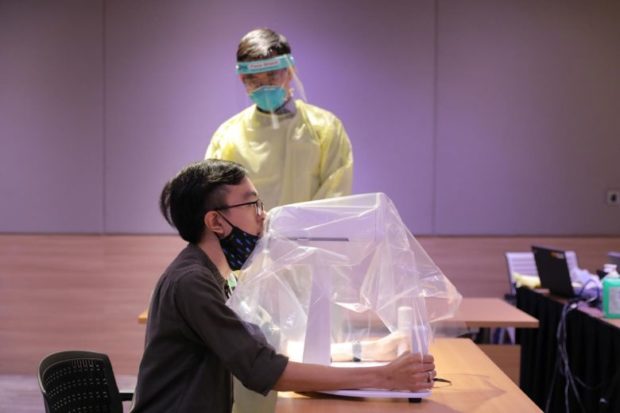New COVID-19 swab test robot offers safe, more comfortable procedure for patients

The made-in-Singapore bot allows patients to fully control the swab process for more comfort. ST PHOTO: ONG WEE JIN
SINGAPORE — A robot that carries out nasal swabbing to diagnose Covid-19 has been developed by clinicians who say the automated procedure is safe, faster and more comfortable compared with manual swab tests.
Although other countries have developed similar robots, the clinicians said the made-in-Singapore bot is the first that allows patients to fully control the swab process so they are more comfortable. Patients can activate and terminate the machine at will.
A patient is seated in front of the robot, called SwabBot, similar to how he would take a mechanized eye examination. He holds onto the handhold and latches his nostril onto the disposable nosepiece.
After the patient activates the bot by using his chin to push a button, the nosepiece moves slightly upwards to open the nostril. The swab will extend and rotate safely and gently through the patient’s nose to the back of the nasal cavity, which is typically about 10cm from the nostrils.
SwabBot is equipped with a built-in feature that withdraws the swab stick if there is resistance when it is moved deeper into the nasal cavity. If patients feel uncomfortable at any point, they can stop the process by moving their head away from the robot.
The process takes 20 seconds, while a manual swab test can take twice as long.
At the end of the procedure, a medical staff member will open the machine to remove and store the swab stick. The robot, including its interior, will be wiped down and covered with a fresh plastic drape fitted with a nosepiece for the next patient.
The machine, which is 35cm by 40cm, and 49cm high, was developed by clinicians from the National Cancer Centre Singapore (NCCS) and Singapore General Hospital (SGH), in collaboration with medical robotics company Biobot Surgical.
The team said the robot can address the limitations and risks of manual swabbing. It reduces swabbers’ risk of exposure to the virus and the need for training people, standardizes the consistency of swabs taken, and increases the efficiency of conducting swab tests.
“Our team felt that we had to find a better way to swab patients to reduce the risk of exposure of Covid-19 to our healthcare workers, especially when patients sneeze or cough during the swabbing process,” said principal investigator Rena Dharmawan, associate consultant of head and neck surgery at NCCS’ Division of Surgery and Surgical Oncology.
Beyond that, the clinicians wanted to make the swabbing procedure more comfortable for patients.
SwabBot retains the same gentle touch and precision as surgeons who perform very delicate procedures, said Dr Luke Tay, consultant at SGH’s Department of Vascular Surgery, who is one of the project’s team members.
“When patients are empowered and fully in control of the swabbing process, they are mentally prepared and experience subjectively less pain,” added Dr Dharmawan, who is also the clinical entrepreneur-in-residence at Duke-NUS Medical School’s Centre of Technology & Development.
Although some find a typical swab test very uncomfortable, it is generally painless, although there may be some degree of discomfort or ticklishness, and patients may feel like sneezing or coughing during the process. Some patients may tear up as well.
To date, 85 SGH and Bright Vision Hospital patients, and volunteers, have participated in the ongoing clinical trial that compares SwabBot against manual swabbing. The feedback received from participants was positive.
All of the participants said the procedure with the robot was either equally or less painful compared to getting a manual swab, said Dr Dharmawan.
Volunteer Marco Lizwan, 25, a second-year medical student at Duke-NUS Medical School, said he was less worried when he was swabbed by the robot.
“I found the robot more comfortable because you can (turn it on) whenever you are ready. So things are within your control. I was worried when I did the manual one because I was wondering if the swabber’s hand will be shaky.”
Mr Ariata Elizer Ellevera, a 49-year-old migrant worker admitted to Bright Vision Hospital for Covid-19, said: “The experience was painless, and the process of swabbing by the robot was very quick.”
The project was initiated in April, and it took three months to build the machine.
SingHealth and Biobot Surgical have filed a patent for SwabBot’s technology. Biobot is also working to get the robot CE marked for it to be commercialised globally. A CE mark is a symbol that must be affixed to products before they can be sold in the European market.
Two months ago, a Taiwanese medtech firm developed a robotic arm that can conduct nasal swabs by using a depth-sensing camera. A start-up in Denmark also recently invented a fully automated throat swab robot.
For more news about the novel coronavirus click here.
What you need to know about Coronavirus.
For more information on COVID-19, call the DOH Hotline: (02) 86517800 local 1149/1150.
The Inquirer Foundation supports our healthcare frontliners and is still accepting cash donations to be deposited at Banco de Oro (BDO) current account #007960018860 or donate through PayMaya using this link.